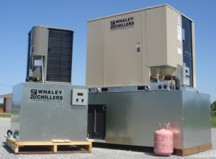Water Quality Assocation
Bottled Water Organization
Whaley Products
Application Description:
To understand “reverse osmosis,” it is probably best to start with normal osmosis. According to Merriam-Webster’s Collegiate Dictionary, osmosis is the “movement of a solvent through a semipermeable membrane (as of a living cell) into a solution of higher solute concentration that tends to equalize the concentrations of solute on the two sides of the membrane.” That’s a mouthful.

The salt concentration becomes the same on both sides of the membrane (which isn’t going to happen in this case since there is pure water on one side and salty water on the other).
The water pressure rises as the height of the column of salty water rises, until it is equal to the osmotic pressure. At that point, osmosis will stop.
Osmosis, by the way, is why drinking salty water (like ocean water) will kill you. When you put salty water in your stomach, osmotic pressure begins drawing water out of your body to try to dilute the salt in your stomach. Eventually, you dehydrate and die.
In reverse osmosis, the idea is to use the membrane to act like an extremely fine filter to create drinkable water from salty (or otherwise contaminated) water. The salty water is put on one side of the membrane and pressure is applied to stop, and then reverse, the osmotic process. It generally takes a lot of pressure and is fairly slow, but it works.
 Packaged Chillers Non-expandable (integrated pump tank) 1.5Ton – 20Ton Single / Dual Circuits Single / Dual Pumps |
 SAE Series Modular Chillers Expandable (pump & tank on separate skid) 1.5Ton – 200Ton Single / Dual Circuits |
 SAR Series Split Chillers Expandable (Outdoor Condensing Unit) (pump, tank, evaporator on indoor skid) 1.5Ton – 200Ton Single / Dual Circuits |
